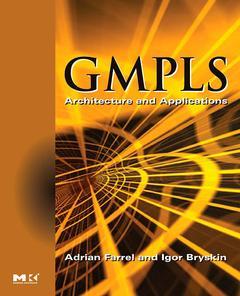Description
GMPLS
Architecture and Applications
The Morgan Kaufmann Series in Networking Series
Authors: Farrel Adrian, Bryskin Igor
Language: English
Approximative price 65.08 €
Subject to availability at the publisher.
Add to cart
Publication date: 12-2005
412 p. · 19x23.4 cm · Paperback
412 p. · 19x23.4 cm · Paperback
Description
/li>Contents
/li>Readership
/li>Biography
/li>Comment
/li>
The last two years have seen significant developments in the standardization of GMPLS and its implementation in optical and other networks. GMPLS: Architecture and Applications brings you completely up to date, providing the practical information you need to put the growing set of GMPLS-supported services to work and manage them effectively.
This book begins by defining GMPLS’s place in a transport network, leveraging your knowledge of MPLS to give you an understanding of this radically new control plane technology. An overview of GMPLS protocols follows, but the real focus is on what comes afterwards: in-depth examinations of the architectures underpinning GMPLS in real-world network environments and current and emerging GMPLS applications. This one-of-a-kind resource delivers immensely useful information for software architects, designers and programmers, hardware developers, system testers, and network operators--and also for managers and other decision-makers.
+ Written by two industry researchers at the forefront of the development of GMPLS.
+ Provides a practical look at GMPLS protocols for signaling, routing, link and resource management, and traffic engineering.
+ Delves deep into the world of GMPLS applications, including traffic engineering, path computation, layer one VPNs, point-to-multipoint connectivity, service management, and resource protection.
+ Explores three distinct GMPLS control plane architectures: peer, overlay, and hybrid, and explains the GMPLS UNI and NNIs.
+ Explains how provisioning challenges can be met in multi-region networks and details the provisioning systems and tools relied on by the GMPLS control plane, along with the standard MIB modules used to manage a GMPLS system.
This book begins by defining GMPLS’s place in a transport network, leveraging your knowledge of MPLS to give you an understanding of this radically new control plane technology. An overview of GMPLS protocols follows, but the real focus is on what comes afterwards: in-depth examinations of the architectures underpinning GMPLS in real-world network environments and current and emerging GMPLS applications. This one-of-a-kind resource delivers immensely useful information for software architects, designers and programmers, hardware developers, system testers, and network operators--and also for managers and other decision-makers.
+ Written by two industry researchers at the forefront of the development of GMPLS.
+ Provides a practical look at GMPLS protocols for signaling, routing, link and resource management, and traffic engineering.
+ Delves deep into the world of GMPLS applications, including traffic engineering, path computation, layer one VPNs, point-to-multipoint connectivity, service management, and resource protection.
+ Explores three distinct GMPLS control plane architectures: peer, overlay, and hybrid, and explains the GMPLS UNI and NNIs.
+ Explains how provisioning challenges can be met in multi-region networks and details the provisioning systems and tools relied on by the GMPLS control plane, along with the standard MIB modules used to manage a GMPLS system.
Contents
Preface
Chapter 1: Generalized Multiprotocol Label Switching
Chapter 2: Transport Networks
Chapter 3: From MPLS To GMPLS
Chapter 4: GMPLS Signaling
Chapter 5: GMPLS Routing
Chapter 6: Link Management
Chapter 7: Resource Management
Chapter 8: GMPLS and Service Recovery
Chapter 9: GMPLS and Traffic Engineering
Chapter 10: GMPLS and Path Computation
Chapter 11: Constraint Based Path Computation
Chapter 12: Emerging Applications
Chapter 13: Architectural Models
Chapter 14: Provisioning Systems
Chapter 15: GMPLS MIB Modules
Glossary
Index
Preface
Chapter 1: Generalized Multiprotocol Label Switching
Chapter 2: Transport Networks
Chapter 3: From MPLS To GMPLS
Chapter 4: GMPLS Signaling
Chapter 5: GMPLS Routing
Chapter 6: Link Management
Chapter 7: Resource Management
Chapter 8: GMPLS and Service Recovery
Chapter 9: GMPLS and Traffic Engineering
Chapter 10: GMPLS and Path Computation
Chapter 11: Constraint Based Path Computation
Chapter 12: Emerging Applications
Chapter 13: Architectural Models
Chapter 14: Provisioning Systems
Chapter 15: GMPLS MIB Modules
Glossary
Index
Software architects, designers and programmers, hardware developers, system testers and network operators looking for a broad description of the purpose and details of GMPLS. Decision-makers and managers tasked with making strategic decisions about the development and deployment of transport networks. Additional market includes special topics courses-- GMPLS is highlighted in many Computer Science syllabuses and there is currently no suitable text for these courses.
Adrian Farrel has nearly two decades of experience designing and developing portable communications software. As MPLS Architect and Development Manager at Data Connection Ltd., he led a team that produced a carrier-class MPLS implementation for customers in the router space. As Director of Protocol Development for Movaz Networks, Inc., he helped build a cutting-edge system that integrated many IP-based protocols to control and manage optical switches. Adrian is active within the IETF, where he is co-chair of the CCAMP working group responsible for GMPLS. He has co-authored and contributed to numerous Internet Drafts and RFCs on MPLS, GMPLS, and related technologies. He was a founding board member of the MPLS Forum, frequently speaks at conferences, and is the author of several white papers on GMPLS.
- Written by two industry researchers at the forefront of the development of GMPLS.
- Provides a practical look at GMPLS protocols for signaling, routing, link and resource management, and traffic engineering.
- Delves deep into the world of GMPLS applications, including traffic engineering, path computation, layer one VPNs, point-to-multipoint connectivity, service management, and resource protection.
- Explores three distinct GMPLS control plane architectures: peer, overlay, and hybrid, and explains the GMPLS UNI and NNIs.
- Explains how provisioning challenges can be met in multi-region networks and details the provisioning systems and tools relied on by the GMPLS control plane, along with the standard MIB modules used to manage a GMPLS system.
© 2024 LAVOISIER S.A.S.




